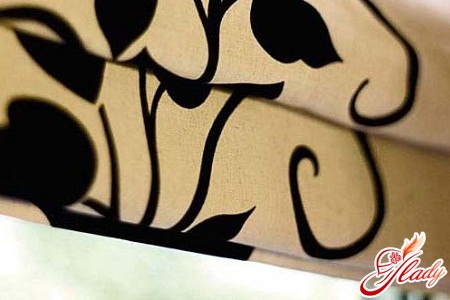 "Sails and caravels, behind the stern a tracefoamy white…” And what do Roman blinds have to do with it, you ask. And this element of window decor came to us from no less than Roman sailors. The blind itself, with all its elegance, is quite simple (if not to say “rough”) in execution. It is made according to the principle of a ship’s sail: a canvas fixed to the mast, capable of being raised or lowered with the help of a special device. If everything is so simple, you say, then how can you sew Roman blinds yourself? Very easy, we will answer and offer you several options for Roman blinds at once, sewn without much effort (but with a certain amount of effort!).
"Sails and caravels, behind the stern a tracefoamy white…” And what do Roman blinds have to do with it, you ask. And this element of window decor came to us from no less than Roman sailors. The blind itself, with all its elegance, is quite simple (if not to say “rough”) in execution. It is made according to the principle of a ship’s sail: a canvas fixed to the mast, capable of being raised or lowered with the help of a special device. If everything is so simple, you say, then how can you sew Roman blinds yourself? Very easy, we will answer and offer you several options for Roman blinds at once, sewn without much effort (but with a certain amount of effort!).
What do we need for this?
Keep in mind that you will need much less fabric than for traditional curtains, but more accessories and additional materials:
- straight cut tknani by the size of the window or a little more;
- lining fabric (for one of the models);
- Velcro tape (tape-fastener along the width of the curtains);
- sealant on the glue base for the edge (fleece, bortovka);
- seven or eight pins of wood or metal, whose length is three centimeters less than the width of the future curtain (for the frame);
- Plastic or wooden rings (in which the cord will be threaded for lifting the curtains);
- three pieces of the cord itself (the length of each is two lengths of the curtain plus its width;
- weighting bar;
- wooden plank, on which the curtain will be suspended;
- a special holder-stopper for cords;
- nails, screws and hooks.
Choose a cut, stock up on everything you need andstart making the curtain. By the way, the Roman blind is the most affordable way of expensive textile design. Because with minimal fabric consumption (and it is exactly like that here) you can afford to buy expensive fabric. Well, what kind of fabric to choose, decide for yourself. If you want your Roman blind to protect you from the sun, choose thick fabrics or fabrics with a special treatment on the inside (fabrics "black out"). Translucent fabrics on the windows will hide your life from prying eyes, but will let light into the room. Pay attention to the pattern: in a Roman blind it will look especially advantageous. And fabrics with an interesting or complex weave of threads can also be a very effective option. Well, now, having decided on the fabric and purchased all the necessary materials, we proceed to the selection and manufacture of the model.
The first model. The simplest and easiest option
This is a model without pins, but with a weight that will keep the bottom edge of the curtain horizontal. Its advantages are ease of execution, softer folds and a casual look.
The second model. Option with bar guard
This model is best suited for curtains made of plain fabrics with a loose structure. The main condition for its neat appearance is precision cutting and loose stitching (not tightening the fabric).

The third model. The most popular option
This option is especially popular,because it is quite easy to sew a Roman blind yourself in this way, but the result will be more spectacular than in the first model. For it, absolutely any fabric is used as a base, but the lining must necessarily match the base in tone.
The fourth model. Variant with a figured bottom
No special instructions are needed here.You can make such a Roman blind on the basis of any model. The only difference will be a figured bottom, cut with scallops or a patterned line. For this model, instead of instructions, you only need some recommendations. If you want the figured bottom to peek out from under the folds of the curtain during assembly, then do the following. When cutting, divide the full height of the curtain into sections so that the first section is measured from the bottom of the figured edging. Sew the lowest rings for the cord not to the weight, but to the lower drawstring with a rod. If you sew a curtain with a peeking edging according to the sample of the first model (without rods), then make the edging itself wider - not ten, but twenty-five centimeters.
How to fix Roman curtains?
Roman blinds can be fixed either insidewindow opening, or along its edge. In accordance with this option, calculate the fabric consumption and make a pattern. The first option is appropriate if your window has very wide window sills or if the Roman blind is used together with regular curtains. In this case, it is located very close to the glass and leaves the window sills free. The second option is preferable if your window has folding sashes and opens along its entire height. In this case, the curtain is cut so that it covers the wall (slopes) by five to ten centimeters on both sides of the window. The process of attaching the curtain to the window looks like this:
- to the underside of the wooden bar (bar), on which the curtain will be fastened, nail with the furniture studs (or with the help of a furniture stapler) the tape-Velcro;
- on the bottom of the Velcro on the rod, screw the screws through the same distances (they should have rings instead of the hats);
- attach the finished curtain to the bar (remember, at the top we also hooked it);
- on one of the side parts of the curtain, beginning with the lower ring, thread the cord through all the rings and at the bottom tie it with a knot (for strength you can glue the knot);
- thread exactly the rest of the cords;
- fasten the cords to the strap rings;
- pull out all the cords on one side of the curtains, collect them together and drag through a special stopper holder;
- fix the holder at the very edge of the bar;
- align the ends of the cords, tie them together with a knot;
- at the middle of the window, attach the hook to fix the pick-ups;
- folding the curtain in the "accordion", wind the cords on the hook.
Now that you have removed the cords from the hook, the curtainto go down. That's all, actually. Knowing how to sew Roman blinds with your own hands, how to fix them on the window, you can stylishly and effectively decorate the windows in any room of your house. And say "thank you" to the Roman sailors, thanks to whom the art of making ship sails magically helps to transform our home. We recommend reading:









